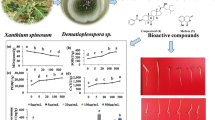Abstract
Triadimefon retarded the elongation of the upper internodes of shoots of tomato and cotton plants. The growth retardation was completely reversed by exogenously applied gibberellic acid (GA3). Growth of coleoptiles, primary leaves and roots of wheat and barley seedlings was reduced after seed treatment with triadimefon; application of GA3 did not completely counteract this growth retardation. Leaves of triadimefon-treated plants showed a darker green colour; leaves became lighter again when the growth retardation was reversed by GA3 application. When detached leaf sections were floated in triadimefon solutions or suspensions in the dark, senescence was delayed. The compound showed only a weak antagonistic effect on GA3-induced α-amylase synthesis in barley endosperm. Triadimefon strongly reduced the synthesis of gibberellin-like substances in Fusarium moniliforme. It inhibited the development of haustoria of Erysiphe graminis f. sp. hordei. Studies on its mode of action revealed that triadimefon blocked ergosterol biosynthesis in Ustilago avenae.
Similar content being viewed by others
References
Barnes, M.F., Light, E.N. & Lang, A., 1969. The action of plant growth retardants on terpenoid biosynthesis. Inhibition of gibberellic acid production in Fusarium moniliforme by CCC and Amo-1618; action of these retardants on sterol biosynthesis. Planta 88: 172–182.
Buchenauer, H., 1975. Systemisch-fungizide Wirkung und Wirkungsmechanismus von Triadimefon (MEB 6447). Mitt. biol. BundAnst. Ld- u. Forstw. 165: 154–155.
Buchenauer, H., 1976. Hemmung der Ergosterinbiosynthese in Ustilago avenae durch Triadimefon und Fluotrimazol. Z. PflKrankh. PflSchutz 83: 363–367.
Coolbaugh, R.C. & Hamilton, R., 1975. Effects of ancymidol on growth and kaurene metabolism in peas. Pl. Physiol., Lancaster 56S: 63.
Frohberger, P.E., 1973. Bekämpfung von Pilzkrankheiten im Getreidebau durch Saatgutbehandlung. Mitt. biol. BundAnst. Ld- u. Forstw. 151: 61–74.
Grewe, F. & Büchel, K.H., 1973. Ein neues Mehltaufungizid aus der Klasse der Trityltriazole. Mitt. biol. BundAnst. Ld- u. Forstw. 151: 208–209.
Harada, H., 1966. Retardation of the senescence of Rumex leaves by growth retardants. Pl. Cell Physiol., Tokyo 7: 701–703.
Jones, K.C., 1969. Similarities between gibberellins and related compounds in inducing acid phosphatase and reducing sugar release from barley endosperm. Pl. Physiol., Lancaster 44: 1695–1700.
Jones, R.L., 1969. Gibberellic acid and the fine structure of barley aleurone cells. II. Changes during the synthesis and secretion of α-amylase. Planta 88: 73–86.
Jones, R.L. & Varner, J.E., 1967. The bioassay of gibberellin. Planta 72: 155–161.
Kaspers, H., Grewe, F., Brandes, W., Scheinpflug, H. & Büchel, K.H., 1975. 1,2,4-Triazole derivatives, a new class of protective and systemic fungicides. Rep. Inf. VIII Int. Pl. Prot. Congr. Moscow, Sect. III Chem. Control: 398–401.
Kende, H., Ninnemann, H. & Lang, A., 1963. Inhibition of gibberellic acid biosynthesis in Fusarium by Amo-1618 and CCC. Naturwissenschaften 50: 599–600.
Leopold, A.C., 1971. Antagonism of some gibberellin actions by substituted pyrimidine. Pl. Physiol., Lancaster 48: 537–540.
Lüttge, U., Bauer, K. & Köhler, D., 1968. Frühwirkungen von Gibberellinsäure auf Membrantransporte in jungen Erbsenpflanzen. Biochim. biophys. Acta 150: 452–459.
Paleg, L., Kende, H., Ninnemann, H. & Lang, A., 1965. Physiological effects of gibberellic acid. VIII. Growth retardants on barley endosperm. Pl. Physiol., Lancaster 40: 165–169.
Ragsdale, N.N. & Sisler, H.D., 1973. Mode of action of triarimol in Ustilago maydis. Pestic. Biochem. Physiol. 3: 20–29.
Waard, M.A. de, 1971. Germination of powdery mildew conidia in vitro on cellulose membranes. Neth. J. Pl. Path. 77: 6–13.
White, N.H. & Baker, E.P., 1954. Host pathogen relations in powdery mildew of barley. 1. Histology of tissue reactions. Phytopathology 44: 657–662.
Ziegler, E. & Egle, K., 1965. Zur quantitativen Analyse der Chloroplastenpigmente. I. Kritische Uberprüfung der spektralphotometrischen Chlorophyll-Bestimmung. Beitr. Biol. Pfl. 41: 11–37.
Author information
Authors and Affiliations
Rights and permissions
About this article
Cite this article
Buchenauer, H., Grossmann, F. Triadimefon: Mode of action in plants and fungi. Neth. J. Pl. Path. 83 (Suppl 1), 93–103 (1977). https://doi.org/10.1007/BF03041424
Issue Date:
DOI: https://doi.org/10.1007/BF03041424




